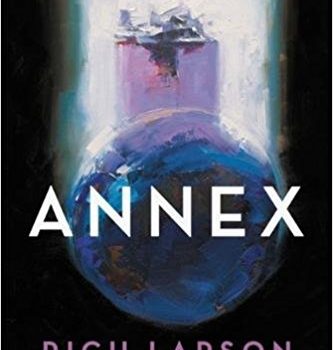Gary K. Wolfe Reviews Annex by Rich Larson
 Annex, Rich Larson (Orbit 978-0-316-41654-2, $15.95, 336pp, tp) July 2018.
Annex, Rich Larson (Orbit 978-0-316-41654-2, $15.95, 336pp, tp) July 2018.
By his own count, Rich Larson has published over 100 stories since 2012, with an impressive number of them making it into year’s best anthologies. That amounts to one of the more stunning debuts in recent SF, even as he’s largely been under the radar for major awards (possibly in part because of that very prolificity). This inevitably creates a great deal of interest in his first novel, and – given his level of output – it’s not surprising that the novel, Annex, is the first of a trilogy to be called The Violet Wars. Violet refers to the trans teenage girl who is easily the most appealing feature of the novel, and who promises to become one of the more memorable and credible of the various kickass heroines who have been cheerfully colonizing SF (especially dystopian SF) over the past several years. In fact, Larson’s colorful cast of characters, mostly teens and younger, but aided by a spectacular shapeshifting alien ally called Gloom, is by far the strongest aspect of what is otherwise something of a magpie novel in its deployment of SF and YA materials.
The basic template seems to be Peter Pan. A group of children who occupy an abandoned theater, after an alien invasion has turned the adults into zombie-like “wasters,” even refer to themselves as Lost Boys and their theater as Neverland. Their leader, Wyatt, is as charismatic as Peter and just as demented, with Violet more-or-less assuming the Wendy role. The kids can’t fly, but some of them do have near-magical powers, thanks to biomechanical “Parasites” implanted by the alien invaders, and the dramatic center of the tale even involves sneaking aboard the pirate ship/alien vessel to rescue those abducted for nefarious purposes. Getting there, however, takes us through a succession of familiar tropes so skillfully woven into this rapid-fire plot that at first we hardly notice the borrowings. Some months earlier, an enormous alien craft appeared above the city, blotting out the sky in the manner of Childhood’s End or Independence Day and cutting it off from the outside world. The adults were rendered useless by back-of-the-neck “clamps” a la The Puppet Masters or John Christopher’s City of Gold and Lead or the 1953 movie Invaders from Mars, giving them the illusion that they are continuing their normal lives (á la The Matrix or huge chunks of Philip K. Dick) while their bodies became little more than mindless automatons. The kids, meanwhile, were rounded up in warehouses and given those parasite implants, the real function of which only becomes apparent later – but with the useful side effect of giving some of them the ability to disappear things by simply concentrating their psychic/static electric powers. Kids who escape are tracked down by grotesque replicas of their moms, called “othermothers” (recalling Lucy Lane Clifford’s “The New Mother” and Gaiman’s Coraline). Those taken aboard the alien ship are suspended in liquid-filled tanks (this image has grown so widespread that TV Tropes has a name for it: “people jars”).
One of the kids who escapes the warehouse is Bo, not yet 12, who learns he has an extraordinarily powerful ability to cause things to disappear – he simply dissolves a portion of the hideous “wormy wall” that isolates the warehouse – and he soon meets Violet, who introduces him to the Lost Boys and Wyatt. Bo’s only real goal, however, is to rescue his older sister Lia – who may prove to be as important an asset to the aliens as Bo himself. There’s something celebratory and unapologetically old-fashioned about the adventures that follow – the motives of the overlord aliens never make much more sense than they ever do, and it’s not long before we find there’s a longstanding galactic war going on – but Larson has enriched this familiar choreography with a vividly imagined nightmare landscape of wasters, “whirlybirds,” othermothers, and gaseous floating alien pods – and more importantly, casting the whole thing with believably young kids (not the precocious cartoons who could be played by twenty-something actors) caught in a world where they are at once liberated from adult oversight – and in some cases like Violet’s, parental abuse – and faced with the challenge of plotting their own survival. If a lot of what Annex has to offer seems familiar, these kids and Larson’s breakneck pace end up making it exhilarating, and well worth waiting for the next volume.
Gary K. Wolfe is Emeritus Professor of Humanities at Roosevelt University and a reviewer for Locus magazine since 1991. His reviews have been collected in Soundings (BSFA Award 2006; Hugo nominee), Bearings (Hugo nominee 2011), and Sightings (2011), and his Evaporating Genres: Essays on Fantastic Literature (Wesleyan) received the Locus Award in 2012. Earlier books include The Known and the Unknown: The Iconography of Science Fiction (Eaton Award, 1981), Harlan Ellison: The Edge of Forever (with Ellen Weil, 2002), and David Lindsay (1982). For the Library of America, he edited American Science Fiction: Nine Classic Novels of the 1950s in 2012, with a similar set for the 1960s forthcoming. He has received the Pilgrim Award from the Science Fiction Research Association, the Distinguished Scholarship Award from the International Association for the Fantastic in the Arts, and a Special World Fantasy Award for criticism. His 24-lecture series How Great Science Fiction Works appeared from The Great Courses in 2016. He has received six Hugo nominations, two for his reviews collections and four for The Coode Street Podcast, which he has co-hosted with Jonathan Strahan for more than 300 episodes. He lives in Chicago.
This review and more like it in the July 2018 issue of Locus.
 While you are here, please take a moment to support Locus with a one-time or recurring donation. We rely on reader donations to keep the magazine and site going, and would like to keep the site paywall free, but WE NEED YOUR FINANCIAL SUPPORT to continue quality coverage of the science fiction and fantasy field.
While you are here, please take a moment to support Locus with a one-time or recurring donation. We rely on reader donations to keep the magazine and site going, and would like to keep the site paywall free, but WE NEED YOUR FINANCIAL SUPPORT to continue quality coverage of the science fiction and fantasy field.







